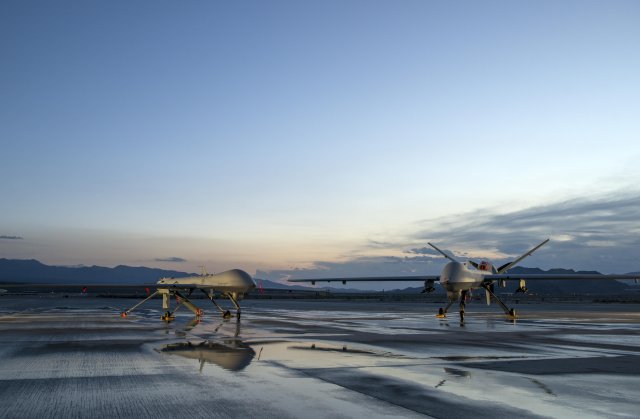Breaking news
USAF comments transition from MQ-1 Predator to MQ-9 Reaper UAV.
| a | |||
|
|
|||
|
World Defense & Security News - United States
|
|||
|
|
|||
|
USAF comments transition from MQ-1 Predator to MQ-9 Reaper UAV
|
|||
|
(By Senior Airman Christian Clausen, 432nd Wing/432nd Air Expeditionary Wing Public Affairs)
For the past 21 years, the US Air Force has flown the MQ-1 Predator remotely piloted aircraft in combat, and for the last 10, the MQ-9 Reaper. Combined with a skilled aircrew, these aircraft provide consistent support in daily engagements making an impact downrange. |
|||
|
|
|||
 An MQ-1 Predator and an MQ-9 Reaper assigned to the 432nd Aircraft Maintenance Squadron remain ready for their next mission at Creech Air Force Base, Nev. An MQ-1 Predator and an MQ-9 Reaper assigned to the 432nd Aircraft Maintenance Squadron remain ready for their next mission at Creech Air Force Base, Nev. (Credit: USAF/Staff Sgt. Vernon Young Jr.) |
|||
|
|
|||
|
While the MQ-1 has provided many years of service, the time has come for the Air Force to fly the more capable MQ-9 exclusively, and retire the MQ-1 in early 2018 to keep up with the continuously evolving battlespace environment.
The MQ-9 is better equipped than the MQ-1 due to its increased speed, high-definition sensors and the ability to carry more munitions. These combat attributes allow the MQ-9 to complete a wider array of mission sets, which can help the Air Force stay prepared in the fight. "When you ask about readiness, you have to ask ready for what?" said Col. Joseph, 432nd Operations Group commander. "If we talk about the things we could be ready for and what we should be asking our attack squadrons to do, then transitioning to an all MQ-9 force is imperative for readiness." Current areas of responsibility call upon combat RPAs for more precise close air support engagements from the attack squadrons, a considerable change from the days when RPAs were used solely for intelligence gathering and real-time reconnaissance. "The reason that the MQ-9 has turned into a CAS platform, and this is the key point, is the fusion of two things," he said. "The first thing is the technology. We took an airplane and outfitted it with more raw power and capability, but then we did the other half and matted that technology with a professional aircrew." Joseph also explained a third item, which is the trust developed with combatant commanders and troops on the ground. This confidence, combined with an ever-changing battlefield, spawned increased demand and desire for more combat RPA support. While the MQ-1 and the crews who flew them proved their weapons proficiency, it was never originally designed to carry weapons, resulting in a limited 200-pound payload. The demand for more attack capabilities exceeded the MQ-1s design. "In the case of the MQ-1, I think we wanted more out of it, but we were at a physical stop on the airplane and needed a new one," Joseph said. The fresh MQ-9 design picked up where the MQ-1 left off, boasting a nearly 4,000-pound payload and the ability to carry missiles and bombs. These upgraded capabilities directly impact combat readiness and transitioning to just the MQ-9 will also help the aircrews stay primed and ready to go. "Having a single aircraft buys more flexibility, simplifies training and logistics and gives our people more [career progression] opportunities," Joseph said. "I can't move my people in between squadrons without paying the penalty of having to train them on another aircraft” The Air Force will no longer have to maintain a training pipeline or equipment on two separate aircraft, which also eliminates the cost of operating two different airframes. Instead, everything will be specific to the MQ-9. "I think when we look at the legacy of the MQ-1 we're going to be scratching our heads wondering how we did so much with so little," Joseph said. "The men and women flying them starting with two squadrons took a science project and throughout many evolutionary changes made it what it is today." The MQ-1 began as the RQ-1 Predator, an unarmed RPA flown by line-of-sight. Some changes include the adding of the Multi-Spectral Targeting system, the addition of weapons and remote-split operations capability. "The MQ-1 is a great example where the Air Force took a technology demonstrator and turned it into a major weapons system having daily effects on the battlefield," James said. "We have found how to fly an imperfect weapons system very well, and I think we have maximized the effectiveness that we can get out of the MQ-1. I have no doubt that we will continue to find ways to be more effective in combat with the MQ-9." James also said the desire for the real-time reconnaissance and persistent strike capabilities that combat RPA aircrew provide to the combatant commanders would never stop. "We're hitting a home run by going to the MQ-9," James said. "We have made a difference." |
|||






















